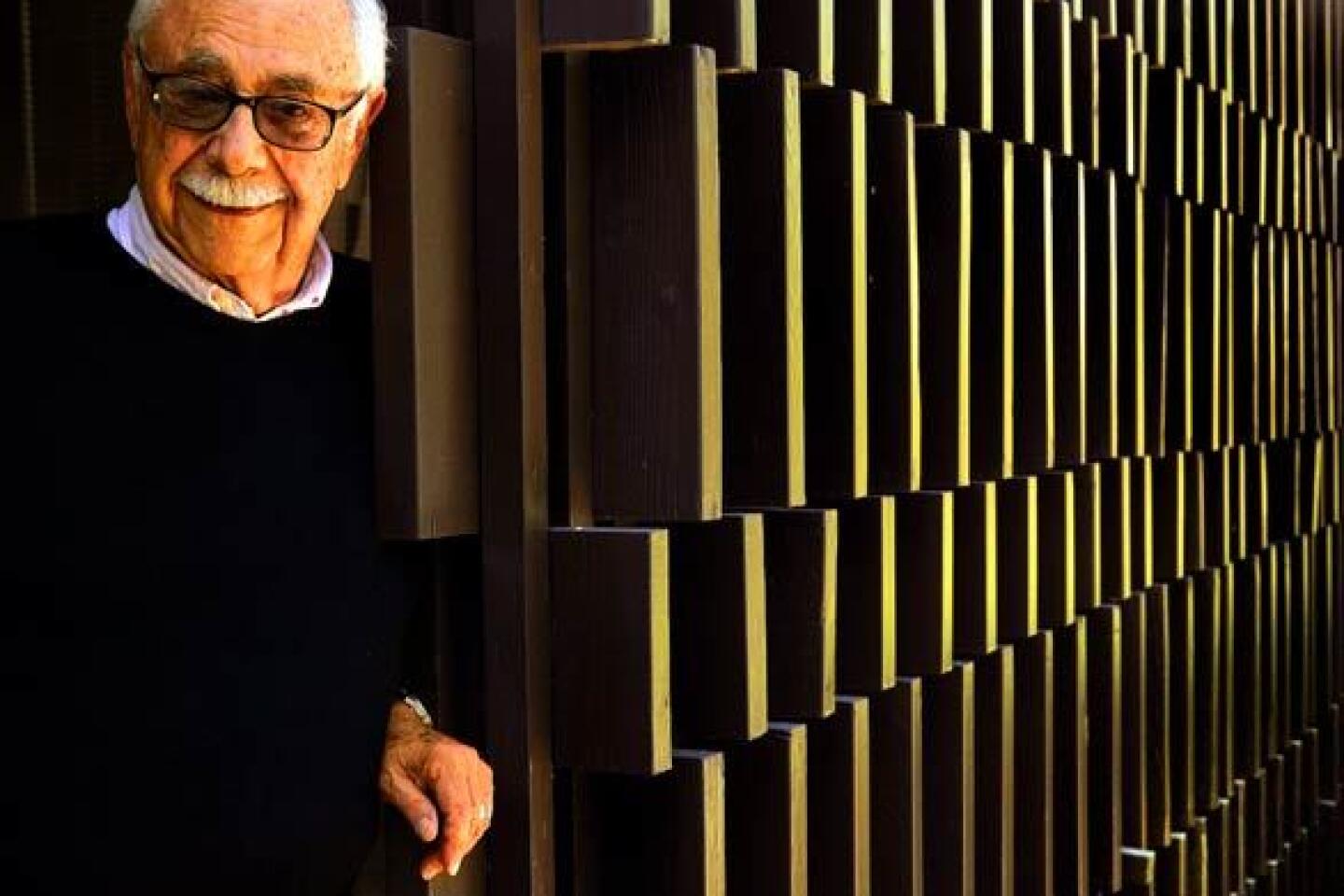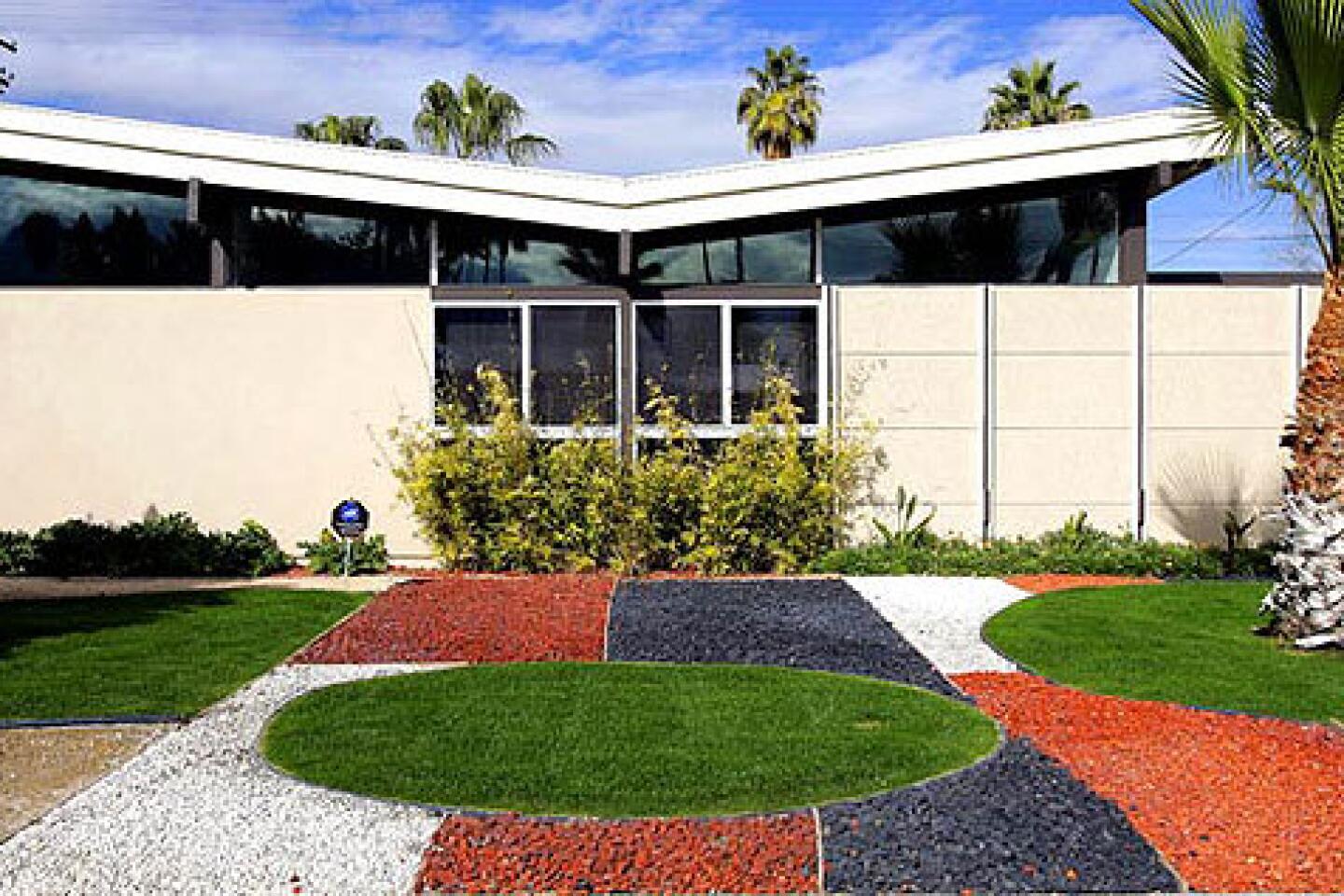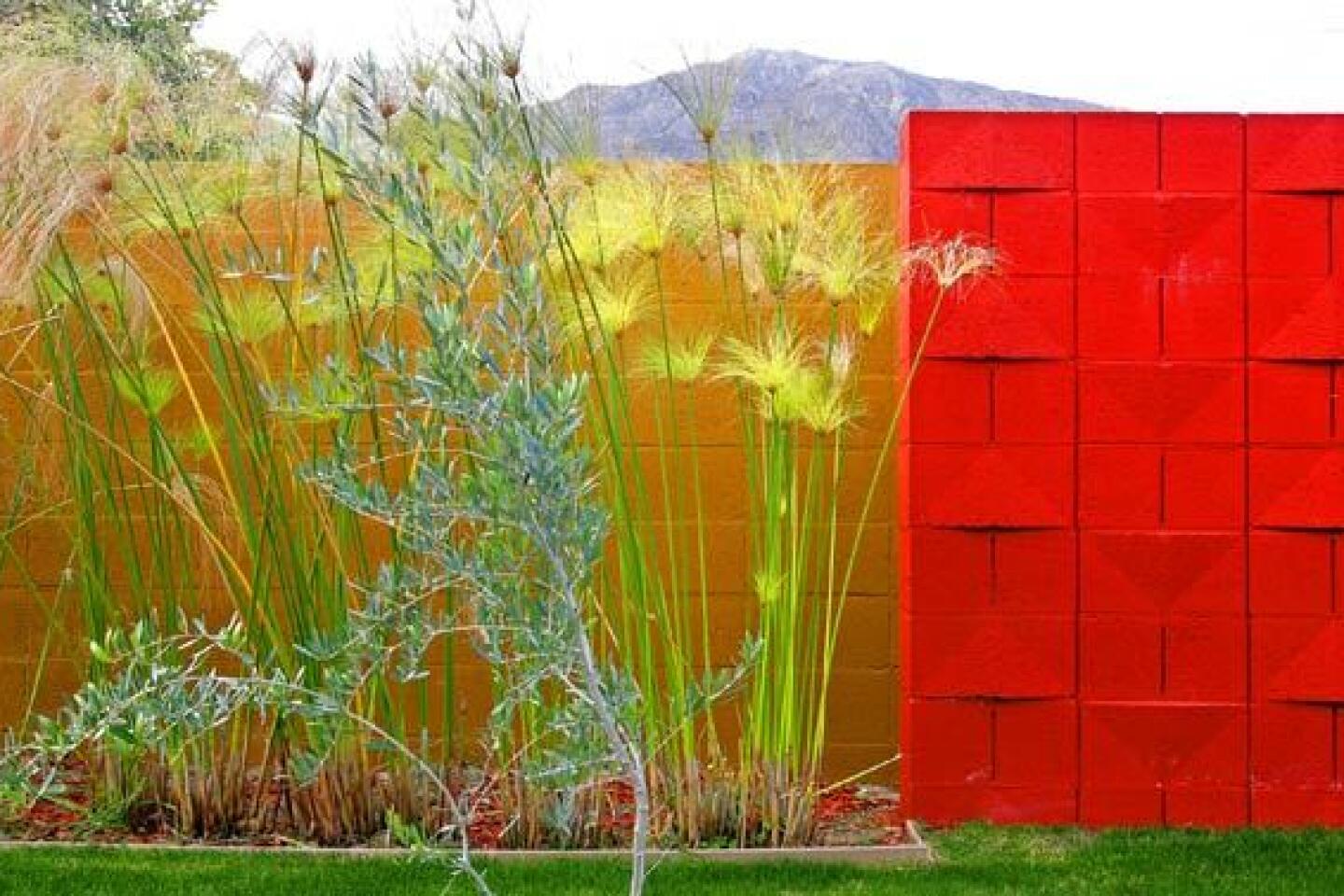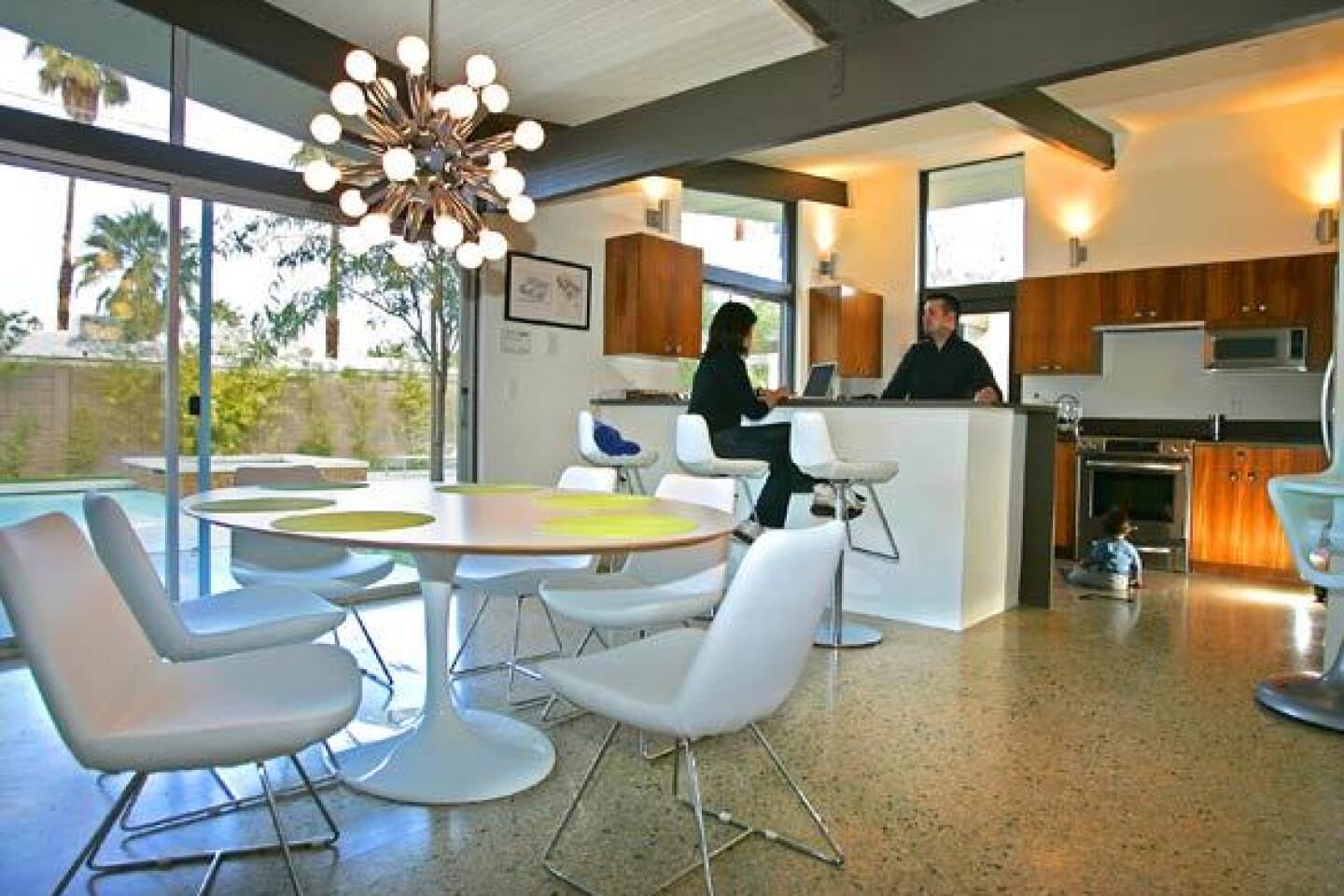Modern’s everyman
- Share via
PALM SPRINGS — JENNIFER CABALQUINTO and Howard Joyce already had put a deposit on a house in a gated golf community when their Realtor steered them to yet another new home, which she said was by architect William Krisel. “We’d never heard of Krisel,” recalls Cabalquinto. “We were on our way home. Our infant son was fussing in his car seat. We didn’t even want to go in.”
They did it to please the agent. And a few minutes later, they emerged “totally in love with the place,” Cabalquinto says. “It was instantaneous for both of us.” The couple made an immediate full-price offer and moved into the just-built house seven months ago.
The design that so instantly enchanted them isn’t actually new at all. It’s a reproduction of a 1955 home by Krisel, updated by him to current codes and filled with 21st century technology. The open floor plan, the high beamed ceilings, the walls of glass and the clerestory windows that offer glimpses of sky and swaying palms are exactly as the architect envisioned 53 years ago.
Krisel, 83, and unflappably urbane, says he’s lived too long to be shocked by anything. But 20 years have passed since he retired as a practicing architect, so he was “just a bit surprised” to be asked again to create plans for the little butterfly-roofed, post-and-beam structure that became a kind of signature Palm Springs residence half a century ago. In fact, if a developer follows through, a whole new colony of reproduction Krisels could rise in the desert. Besides the one bought by Cabalquinto and Joyce, three others already have been built.
Krisel never won as much acclaim as Richard Neutra or Albert Frey, architects who designed the extraordinary custom homes that defined midcentury desert modernism. But it was Krisel who helped to popularize it, bringing that same spirit to affordable housing for the middle class.
Working with the Alexander Construction company in the 1950s, Krisel saw 2,500 of his tract houses built in Palm Springs, nearly doubling the size of that city. Whole neighborhoods of his original homes still exist, as if in a time warp.
Wide, curving streets front gardens behind which Krisel carefully angled the houses in varying positions on their 100-foot-square lots. He alternated styles of roofs, so that each house looked different from its neighbor. A casual observer still might take these streets for charming communities of custom-built homes, but all were mass-produced and have the same floor plans, Krisel says.
He helped to break the mold for affordable housing not only in Palm Springs, but also in the west San Fernando Valley in the 1950s.
“Before that, affordable tract houses were tacky, low-ceiling cracker boxes with holes poked out for windows,” he says.
Though he went on to design high-rise office towers, condominiums, hotels and hospitals, those modest post-and-beam tract houses are what have become most iconic.
In the San Fernando Valley, where many of his homes had been renovated beyond recognition, young families are moving in and painstakingly restoring them to their original condition. In the desert, where his homes have been more consistently maintained, owners frequently phone Krisel for advice on how to update them without ruining their design integrity.
Architecture critic Alan Hess says Krisel and his design partner Dan Palmer, who died last year, deserve every bit of the increased attention that their work has been getting.
“They brought excellent and elegant modern design to mass-produced housing,” Hess says. “That’s significant because every big name in modern architecture at midcentury tried to crack into the mass-produced housing market. And they all failed. Palmer and Krisel, who weren’t at all well-known, solved the problem.”
Michael Stern, curator of the “Julius Shulman: Palm Springs” exhibition opening Friday at the Palm Springs Art Museum, says he has devoted an entire wall in the show to the work of Palmer and Krisel.
“What Bill Krisel did was bring modernism to the masses,” Stern says. Before him, only the wealthy could build modern homes, commissioning well-known architects and the costly materials they used. “Krisel packed excellent architecture into houses of modest size, made of modest materials, and he did it on a very thin dime.”
KRISEL was a young married man, fresh out of USC and stints in the studios of noted architects Paul Laszlo and Victor Gruen, when he realized he was a bit too late to compete with the likes of Neutra and Rudolph Schindler.
“I was just starting out, they were already well-established,” Krisel says. “Why hire me when you could get one of them?”
He looked for a niche not yet tackled and found it in a fortuitous friendship with Bob Alexander, son of builder George Alexander, who was putting up tracts of unattractive but affordable houses for the postwar generation. “I knew homes by the big-name modernists were priced way beyond middle-class reach,” Krisel says. “I also knew no one was offering affordable modernism for that market.”
So Krisel drew up some plans, told his friend Bob that his houses would sell better and make more money than the ones his father was building. “But Bob’s father thought we were nuts,” Krisel says.
“He wanted to teach us young upstarts a lesson. So he gave us land in the Valley to build 10 of my houses as a test.”
Krisel’s homes not only sold fast but also made more profit than the company’s “cracker boxes.” Impressed, George Alexander suggested they build slightly larger, more luxurious Krisel tracts in Palm Springs as vacation homes for those same budget-conscious customers who could never aspire to the extravagant oases built for Hollywood’s elite.
Those original $20,000 tract homes, now known as “Alexanders,” today sell for up to $900,000, says Arleen Ruby-Leviton, the Rancho Mirage Realtor who worked with Cabalquinto and Joyce. A new modern version sells for about $950,000.
Cabalquinto, 38, and Joyce, 37, spend weekdays in their airy Mount Washington house with wraparound decks, but it’s their retreat in Palm Springs that they think of as home.
“We spend almost every weekend here,” says Cabalquinto, chief financial officer of Universal Studios Hollywood. “It’s where we celebrated Thanksgiving and Christmas, where we invite family and friends. This is our keeper, the one we want our son Jack to inherit when he grows up.”
Their new, three-bedroom, two-bath house (with another large bedroom and full bath in the separate guest house) gives them midcentury modern design, which they love, but with 21st century amenities: updated climate control, tankless water heater, stainless steel kitchen, luxury bathrooms and extra storage space built into the two-car garage.”It’s the best of both worlds,” Cabalquinto says. She and her husband, a management consultant, had looked at vintage homes in the area, but they all needed work. “We have demanding jobs, a baby -- we didn’t want such complications.”
When they walked into Krisel’s new version, “we instantly felt it was ours,” she says. “It was so perfect, so light, so spacious. It makes you feel relaxed.”
What sealed the deal, she adds, were the twin palms in the yard. “We had twin palms as the motif for our wedding. We have it embroidered on towels. This house was meant for us.”
The undivided living, dining and kitchen area -- with beamed ceiling, fireplace and terrazzo-like floor -- opens onto the walled garden and pool for an indoor-outdoor feel.
The white Eero Saarinen Tulip dining table, their one “serious” piece, was chosen for its period looks. “We love midcentury modern, but we didn’t want to be cliché about it,” Cabalquinto says. “I tried for clean lines, no clutter, and pieces we won’t worry about when our son starts climbing on them.”
Glints of pale green glass in the floor lent her the color scheme: a soft-green sofa and two patterned barrel chairs that swivel, so guests can face the kitchen or the living room.
A Takashi Murakami lithograph hangs above the fireplace. Most stunning is a colorful canvas divided into three segments of similar abstract patterns. It’s not an artwork, exactly, Cabalquinto says. “It’s a picture of the structure of our family’s DNA -- Howard’s, mine and our son Jack’s.”
THE couple’s “keeper” would never have been built if it weren’t for two Canadian brothers, Bob and Michael Friedman, who wanted to escape with their parents from Calgary’s winter chill. For one month they rented a Palm Springs house that happened to be a vintage Krisel design. What beguiled them was nothing so superficial as its good looks.
“It was the extraordinary experience of living there,” Bob Friedman says. “The floor plan was open but gave us each so much privacy. There was a great relationship between indoors and out. The walls of sliding glass doors, the clerestory windows -- looking up, you saw the tops of palms and mountains. Or else the garden and pool. From almost every room there was outdoor access. We felt like we were part of the landscape.”
Being builders, he says, they realized “there was genius in the simple post-and-beam design, like a child’s puzzle you could easily fit together. Krisel had pared the house down to essentials.”
They phoned Krisel, who since his retirement from active practice has been doing forensic architecture, which focuses on investigating structural flaws in buildings. The brothers asked him to use his original plans to duplicate the house they loved so much. Krisel relented, but only after he had signed a contract that gave him “total design control over every inch of the project. Not even a nail could be changed from its original spot without my approval,” Krisel says.
He’s not floored by the renaissance of his early work, he says. “After all, modernism isn’t a style or a trend. It’s a language, a philosophy. The components of a structure become its ornamentation.”
After Krisel drew plans to meet current codes, which include increased insulation and double-paned glass, a crew took only four months to build the house that Cabalquinto and Joyce purchased, Bob Friedman says. Current economic conditions have caused the Friedmans to put mass construction on hold, but they hope to build a new community of Krisels in the desert.
Krisel shrugs at the notion. “My contract with them is for five years and 500 houses,” he says. “I’ve already designed about 40,000 dwellings in my career. I don’t get too excited about a few more.”
More to Read
Sign up for The Wild
We’ll help you find the best places to hike, bike and run, as well as the perfect silent spots for meditation and yoga.
You may occasionally receive promotional content from the Los Angeles Times.















